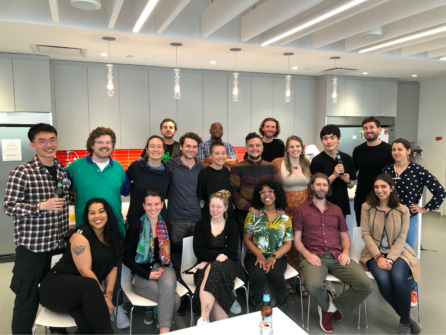How Camille Fulmore Went from Dreams of Traveling to Mars to Dreams of Curing Disease
NewsCamille Fulmore has always known she wanted to be a scientist. Her initial dream of becoming the first woman on Mars may not have come true (yet) but she has found a new mission: helping find better treatments for patients and inspiring the next generation of young scientists. Camille joined the NYSCF Global Stem Cell Array team in 2019 and will soon embark on a PhD at the University of California, Berkeley. We spoke with her about her love of stem cells, what made her NYSCF experience special, and what she hopes the future of STEM will look like.
What sparked your love of science?
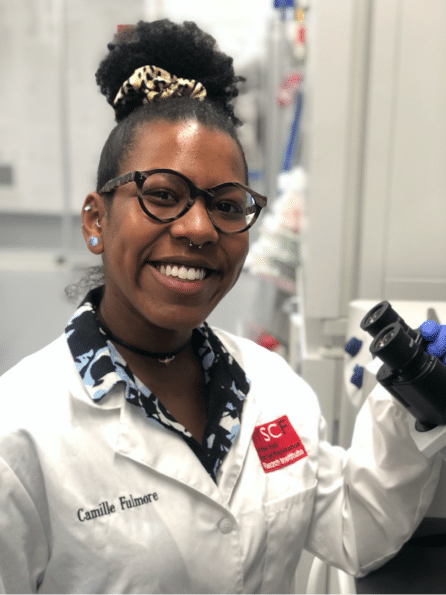
I’ve always had a yearning to help humanity, and I am an innately curious person. In third grade I went on a field trip to NASA and decided I was going to be the first woman on Mars. Then my mom took me to see the movie Contact with Jodie Foster and I was like, ‘that’s what I want to do.’
I did my undergrad at the University of Central Florida and majored in physics with a specialization in astronomy for my first three years, but I started to realize that I wanted to do something where my work could help people more immediately. My dad and brother are chiropractors and my mom is an occupational therapist, so they are always interacting with people and caring for them in their day-to-day jobs, and I wanted to do something more like that. So I switched my major to biotechnology and biomedical science. After I graduated, I did my master’s in biotechnology at NYU.
What made you interested in stem cells?
We started learning about stem cells in my master’s program and I thought they were really cool. I emailed all of the women in New York City who were doing stem cell research and reached Barbara Corneo, the Director of the Stem Cell Core Facility at Columbia University. I started working in her lab and fell in love with stem cell research and tissue culture. Then when I finished my masters, Barbara pointed me to Maura Boldrini – a neuroscientist and psychiatrist at Columbia – and I worked in her lab studying postmortem hippocampal brain tissue.
What brought you to NYSCF?
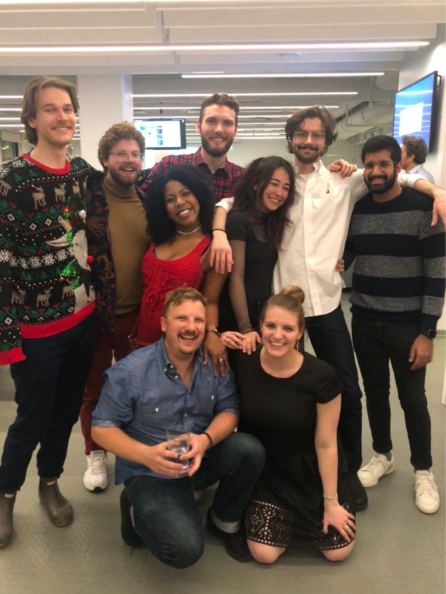
I actually knew about NYSCF and wanted to work there for a really long time before I started. I just really aligned with everything NYSCF was doing, so when I got the job, I was thrilled. I really valued the collaborative environment here: everyone was open to hearing new ideas and trying new things. It made me realize that science is still really dynamic and there’s a lot of exciting work happening.
What did you work on at NYSCF?
I worked on reprogramming cells [reverting skin/blood cells back into stem cells], which was exciting because it is essentially the foundation of what we do – creating patient-specific cells for disease research. I also worked on optimizing our protocols for different lab techniques like single cell sorting, monoclonalization, and the workflow of the robots on the Global Stem Cell Array®.
What did you learn about yourself in your time at NYSCF?
One thing I realized is how much scientific outreach means to me. Growing up, I didn’t see a lot of people like me in STEM. Having that type of representation visible to people, especially kids, I think is really important as we try to inspire the next generation of scientists.
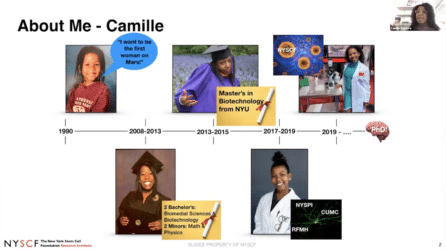
And when the pandemic hit and I wasn’t able to be in the lab as much, I jumped at the opportunity to do more career panels and educational events. My family would log onto the meetings – my mom would go to my grandma’s house and watch it with her, which was awesome. Getting positive feedback on those events has given me a lot of confidence and has helped me discover this passion within myself for education.
What was the most rewarding part of your time at NYSCF?
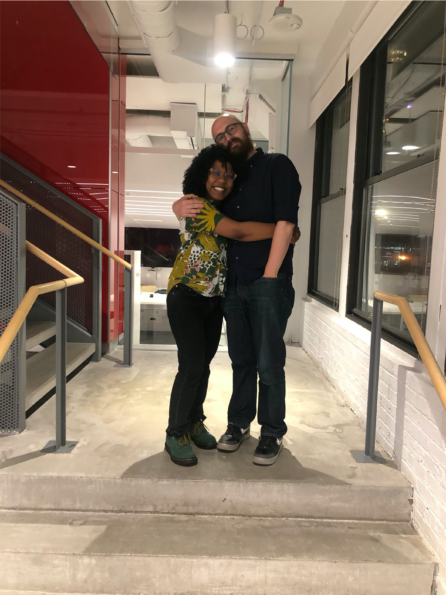
The most rewarding thing about my time here is the relationships I’ve built. I’ve made so many brilliant, motivating friends here and have become a part of a strong scientific community. Dan [Paull, SVP of Discovery & Platform Development] always says that he hopes people who come to NYSCF will either find something they love or figure out something about themselves and move onto bigger and better things. One of my favorite NYSCF memories, actually, is when Dan got everyone a thoughtful Christmas gift with personalized notes and little word searches containing adjectives that describe them – it was so heartwarming. There are so many people here that I know I could call up for advice in the future and who will support me in my career and beyond. NYSCF really gave me a renewed sense of passion for science and empowered me to pursue my PhD.
I also learned so many skills here that I didn’t even know I needed – like how to integrate science with robotics and communicate with data scientists, engineers, and people in different fields. I think a lot of that will be really helpful for my career.
What is your goal for the future?
Part of me would like to go into biotech/pharma because it’s so fast-paced and that’s something I found I really liked at NYSCF – it felt like a fast track for getting cures to people. I also want to see how I feel about teaching – I’ll be teaching some undergrad courses at Berkeley which I’m really looking forward to. I think it could be interesting to start something kind of like the Bio Bus where there’s a mobile center for bringing science to kids.
As far as research, I’d like to use my math and physics background to do more bioengineering. I’ve always been interested in tissues – especially skin. I used to collect my scabs in elementary school and put them in little dishes to see if they would grow. My mom found them and was super grossed out [laughs]. But I think doing bioengineering with skin and bone could be really interesting.
What advice would you give to people who want to take a career path similar to yours?
Never stop advocating for yourself. I’m a very strong believer in the law of attraction: if you keep putting positive thoughts and energy into the world, it will help make things more attainable for you. The second you start to get negative about yourself is when things stop moving for you.
Also, just always keep your connections and don’t burn any bridges. You never know when someone may be able to help you in the future or when you may be able to help them.
